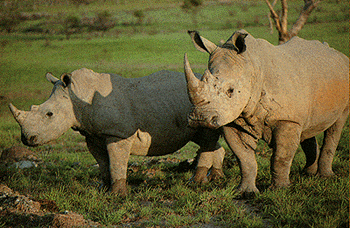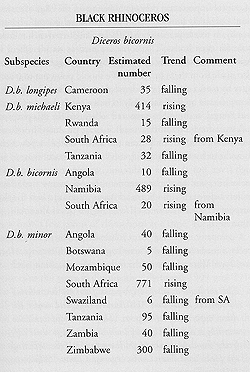Macroevolution: The Future of Biodiversity
Evolution homepage -- BIO 311D homepage
Extinctions and the Future of Diversity
extinction rate change: graph
Examples of human caused extinctions
Major factors threatening species diversity:
a/ habitat loss: deforestation, desertification, draining or flooding areas all cause species with restricted ranges to go extinct. Human-made structures, highways, housing or commercial development claim hundreds of thousands of acres of natural habitats on the American continent each year.
b/ overexploitation: excessive hunting or fishing of game animals, collecting of rare species for private or commercial use
c/ hybridization: crossing with introduced or domesticated relatives results in a loss of the unique genetic identity of the native species
Some North American examples of extinctions:
Black footed ferret (Mustela nigripes): its range covered most of the range of the black- and white-tailed prairie dogs (its primary food source) in the past. By 1984, only 24 ferrets remained in a small colony in Wyoming. Of those 14 were captured; the rest disappeared or died of canine distemper (a disease). Until 1993, this species was extinct in the wild. In Texas the last ferret was seen in 1963 near Muleshoe in the Panhandle. The reason of its disappearance: destruction of prairie dog colonies and habitats.
passanger pigeon: the once abundant species numbering millions of birds was hunted to extinction just in 60 years. The last member of the species died in 1912 in the Cincinnatti zoo.
Coastal race of the greater prarie chicken (also known as Attwater's prairie chicken[Tympanuchus cupido attwateri]): The once fairly abundant subspecies on the coastal plains of Texas and Lousiana now numbers less than 100 birds in the wild. Reason: habitat destruction, turning traditional breeding grounds into croplands and/or intensive grazing lands.
Habitat destruction in the USA. The primary forests of the Pacific Northwest have been almost completely felled and the timber sold. The increased erosion polluted streams and rivers and destroyed the main breeding grounds of Pacific salmons.
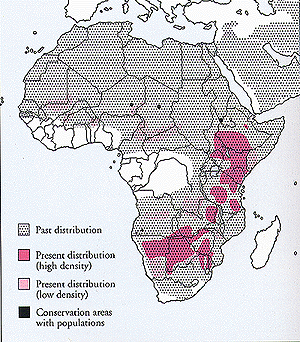
The range of the cheetah (Acinonyx jubatus) has been greatly reduced during the last 60 years due to habitat changes, reduction in its food supply (antelopes), and overhunting.
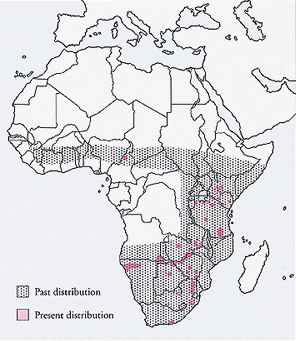
The black rhinoceros' (Diceros bicornis) fate is even more dramatic. It almost has been hunted to extinction just in the last twenty years.
The white rhinoceros (Ceratotherium maximum) is only a little better off then its black relative, as the numbers show. The reason is the same: the powder made from their horns is highly prized in the Middle East and in East Asia.
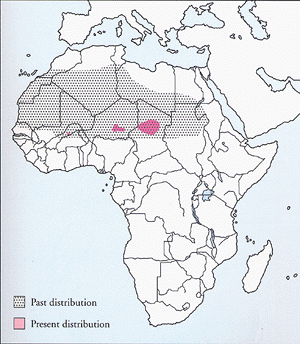
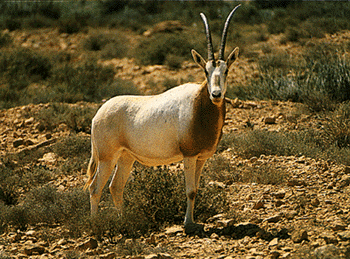
Hunting just for meet has led to the almost complete extermination of this antelope, the Dammah (Oryx dammah).
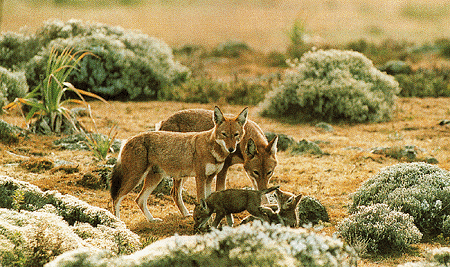
Hybridization with a close relative that has been introduced by humans is another phenomenon resulting in extinction. Here the Ethiopian wild dog (Canis simensis) is shown, which is threatened by extinction through hybridizing with stray domestic dogs.
![]()
The European wild cat (Felis catus) is facing the same problem. Stray domestic cats have already diluted the gene pool of the species to the degree that no pure wild cats exist any more in most of Europe.
![]()
The island of Guam is a deterring example of the outcome of species introductions. The accidental import of the brown snake resulted in the extinction of many endemic bird species that occurred nowhere else. The snakes simply eat them.
Plants in Hawaii have to rely on humans to survive and reproduce. The introduced domestic pigs and goats have chewed and grazed many native plant species to extinction. Many times, their pollinators followed them. The extirpation of feral animals is obstructed by strong hunting interests.
and this list could be continued and continued and continued and continued and continued and continued and continued.......
Macroscope : The Real Biodiversity Crisis
Hybridization and Extinction (color - slow
loading)
Hybridization and Extinction (b/w - faster
loading)
Final words


